Myers' Psychology Unit 1: Sensation and Perception
Module 1.5a Sleep: Consciousness
consciousness is our subjective awareness of ourselves and our environment, allowing us to make sense of our life in sensations, emotions and choices in the present and future
we flit between states of consciousness in various normal waking awareness and various altered states (daydreaming, hallucinations, orgasms, starvation, hypnosis, meditation)
cognitive neuroscience is the interdisciplinary study of the brain activity linked with cognition (thinking, knowing, remembering, communicating)
neuroscientists explore and map conscious functions of the cortex, conscious experience resulting from stimulus crossing a threshold for consciousness
dual processing is the principle that information is often simultaneously processed on separate conscious and unconscious tracks, the conscious being the reflective and the unconscious the intuitive
blindsight is the condition which people can respond to a visual stimulus without consciously experiencing it
visual perception tracks enable us to think about the world and recognize things for future actions
visual action tracks guide our moment-to-moment movements
parallel processing, processing multiple aspects of a stimulus or problem simultaneously, allows us to take care of routine tasks
sequential processing, processing one aspect of a stimulus or problem at a time, is best for processing new information or solving difficult problems
Module 1.5b Sleep: Sleep Stages and Theories
sleep is a periodic, natural loss of consciousness, distinct from unconsciousness resulting from a coma, anesthesia, or hibernation - our consciousness fades as the brain’s cortex stops communicating
while sleeping, we retain perception of the world around us and process information
circadian rhythm is our biological clock or our regular bodily rhythms that occur on a 24-hour cycle
our body temperature rises and falls during the day, similar with thinking and processing alertness
our age and experiences alter our circadian rhythm, with most young adults being night owls with performance improving across the day while older individuals are more morning birds; we gradually shift through aging thanks to our ancestors hunting food
we go through 90 minutes of sleep stage cycles, one being REM sleep (rapid eye movement sleep) or the recurring sleep stage in which vivid dreams commonly occur, or paradoxical sleep because the muscles are relaxed while the body systems are active
alpha waves are waves our brains admits when awake in a relaxed state, eventually slipping into stage 1 sleep during NREM sleep (non-rapid eye movement sleep) which encompasses all sleep stages except for REM sleep
stage 1 sleep may be followed by hallucinations or false sensory experiences like seeing something in the absence of an external visual stimulus
stage 1 may also be followed by hypnagogic sensations or bizarre experiences such as jerking or falling then floating, while transitioning into sleep
stage 2 sleep is characterized by rapid brain-wave activity that aids memory processing for 20 minutes, processing into stage 3 or deep sleep for 30 minutes where your brain emits delta waves (the large slow brain waves associated with deep sleep) hard to awake

instead of continuing in deep sleep, you return to stage 2 before entering into REM sleep, characterized with rapid brain waves where your heart rate rises and breathing becomes rapid and irregular, followed by darting busts of activity of the eye
REM starts the dreams, not actually being real, but convincing the brain to respond if they in fact were
REM and stage 2 are most of our sleep period, as stage 3 becomes shorter and irrelevant

sleep patterns are not the same and do not depend only on age, newborns sleeping more than adults, rather influenced genetically and sometimes passing on insomnia and circadian rhythms
sleep patterns also depend on cultural, social, and economic environments due to school start times, extracurricular activities, bed times, stress, discrimination, and poverty can disturb sleep
new stimulus play affect in activating light-sensitive retinal proteins, which send signals to the brain’s suprachiasmatic nucleus (SCN) or a pair of cell clusters in the hypothalamus that control circadian rhythm, decreasing melatonin production from the pineal gland in response to light
being deprived of light disrupts the 24-hour biological clock and results in desynchronization, more likely to develop fatigue, heart disease, and more
young-adults have adapted to a 25-hour biological clock by staying up too late to get 8 hours of sleep from artificial light delays
adjusting sleep schedules results in a similar jet lag until the biological clock becomes reset from changing stimuli
scientists offer six possible reasons that humans sleep
sleep protects us from harm’s way, ancestors sleeping after days to fit the ecological niche we play in the environment
sleep restores us and gives our body the chance to repair, require, and reorganize; heal from infection, neurons, and can sweep away free radicals that cause Alzehimer’s
sleep consolidates memories and rebuilds our memories of the day into the hippocampus and moves them to storage in the cortex, seeing a performance increase after sleep
sleep feeds creativity and allow us to solve difficult problems, make connections, and learn
sleep grows us and releases hormones from the pituitary gland for muscle development
sleep conserves energy and allows us to preserve our energy for awake times
sleep stage 2 and REM build neural connections that build memories and muscle memories
Module 1.5c Sleep: Sleep Loss, Sleep Disorders, and Dreams
modern sleep patterns leave us drained and out of sense with our well-being, accumulating sleep debt over the last two weeks: eventually we pay off the sleep debt unhindered until falling back into the normal range feeling more energized and happier
students lack sleep and often time get minimal amounts especially with start times leading to deprivation
tiredness triggers aggression and conflicts, predicts depressive disorders, and often times can predict depression rates among individuals throughout life
REM sleep processing of emotion aids against depression and drowsiness, resulting in more sleep, attendance, alertness and better moods
sleep loss also messes with hormones and metabolism disrupting and resulting in weight gains:
increasing ghrelin; a hunger-arousal hormone that decreases the hunger suppressing hormone leptin
increasing cortisol; a stress hormone that stimulates fat production and decreases metabolic rate
disrupts gene expression and enhances limbic brain responses to the inability to resist temptation, fatty foods being enticing
sleep deprivation suppresses immune cells and can make battling viral infections and cancer more of an issue, additionally slowing reaction times and increases issues in the visual attention tasks
we sometimes experience microsleep or quick drifts off of consciousness
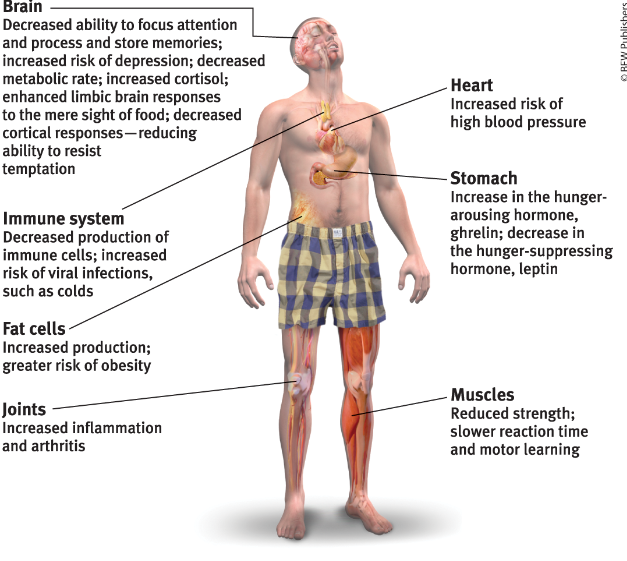
major sleep disorders can affect individuals and make trying to get sleep an issue
insomnia is aggravated by sleeping pills and alcohol causing concentration and memory problems, leading to tolerance
Disorder | Description | Rate | Effects |
Insomnia | Recurring and ongoing problems in falling and staying asleep. | 1 in 5 adults | Chronic tiredness, depression, obesity, hypertension, arthritic pain |
Narcolepsy | A sleep disorder characterized by uncontrollable sleep attacks, entering REM. | 1 in 2000 adults | Falling asleep at dangerous moments, everyday activities suffer and need caution. |
Sleep apnea | A sleep disorder characterized by temporary cessations of breathing during sleep repeated all night. | 1 in 20 adults | Fatigue, depression, obesity - common among men. |
Sleepwalking | A sleep disorder characterized by episodes of complex motor behavior while asleep during Stage 3. | 1-15 in 100 people | Few concerns, often times returning to bed without help and without recall. |
REM | A sleep disorder where REM paralysis does not occur, where twitching, talking, and kicking act out one’s dream. | 1 in 100 adults, increases with age | Risk of accidental injury to people sleeping in bed with them. |
REM dreams are sequences of vivid images, emotions, and thoughts that pass through a sleeping person’s mind
dreams are typically negative emotion associated with failing, attacked, rejected, and misfortune - rarely sexual content
dreams often incorporate recent experiences and preoccupations such as trauma (Auschwitz survivors, 9/11), music (musicians report 2x as many music dreams), vision loss (blind individuals uses nonvisual senses but also their vision in dreams), and media experiences (violent media leads to violent dreams, sexual media leads to sexual dreams)
our minds intake sensory stimulus around us and incorporate it inside of our dreams
while dreaming, we do not remember information around us and often fall back asleep
Sigmund Freud suggests that we sleep to act as a psychic valve; the manifest content (the story line) being a censored version of the latent content (the erotic drives) that would be threatened if expressed (a gun is really a disguised penis)
scientists have proposed various reasons on why we sleep including:
filing away old memories, consolidating our experiences into memory through REM sleep: REM areas become active during sleep that mimic the areas when awake
developing and preserving neural pathways, serving as a physiological function to provide the brain with periodic stimulation
making sense of neural static, or neural activation from the brainstem in the activation-synthesis theory where dreams are the attempt to synthesize together random neural activity happening; emotional dreams happens from emotion in the limbic system
to express cognitive development, overlapping with cognition and speech to simulate reality and engage brain networks to act on top-down control of the dream
Theory | Explanation | Critical Considerations |
Information processing/consolidation | Dreams allow us to sort the day’s events and consolidate our memories. | Why do we dream about stuff that hasn’t happened or past events? |
Physiological function | Regular brain stimulation from REM sleep develops and preserves neural pathways. | Why do we have meaningful dreams then? |
Activation synthesis | REM sleep triggers neural activity that evokes random memories which we create into stories. | We make the stories, which tells us something about the dreamer. |
Cognitive development | Dream content reflects dreamers’ level of cognitive development, simulating our lives including worse-case scenarios. | This does not show why we use dreams as functions. |
REM rebound is the tendency for REM sleep to increase following REM sleep deprivation
Module 1.6a Sensation: Basic Concepts
sensation is the process by which our sensory receptors and nervous system receive and represent stimulus energies
sensory receptors are sensory nerve endings that detect information and transmit them to the brain
perception is the process by which our brain organizes and interprets sensory information enabling us to recognize objects and events as meaningful
our sensory and perceptual processes work together to decipher the world around us
bottom-up information processing begins with the sensory receptors and works up to the brain’s integration of sensory information
top-down information processing is guided by higher-level mental processes, such as perceptions drawn from experience and expectations
our sensory systems perform transduction or the conversion of one form of energy into another, transforming physical energy of sights, sounds, and smells into neural impulses (receive sensory, transform to impulses, deliver to our brain)
psychophysics study the relation between the physical characteristics of stimuli and their intensity to how we psychologically experience them
absolute threshold is the minimum stimulus energy needed to detect a particular stimulus 50 percent of the time
the signal detection theory predicts how and when we detect the presence of a faint stimulus amid background stimulation; assuming there is no absolute threshold and instead depends on experience, expectations, motivation, and alertness
stimuli below absolute threshold for conscious awareness are subliminal
priming is the unconscious activation of associations predisposing perception, memory, and response
difference threshold is the minimum difference between two stimuli required for detection 50 percent of the time
Weber’s law dictates that to be perceived as different, two stimuli must differ by a constant minimum percentage
sensory adaptation is the diminished sensitivity as a consequence of constant stimulation
Module 1.6b Sensation: Vision
our eyes take in pulses of electromagnetic energy which we perceive as color, ranging from gamma to radio wavelengths
light travels in waves and the shape of the waves determines what we can see
wavelength is the distance from the peak of one light or sound wave to the peak of the next, varying from short gamma waves to long radio transmission pulses
the hue is the dimension of color determined by the wavelength of light (colors we know)
the intensity is the amount of energy in a light or sound wave which influences what we perceive as brightness or loudness on amplitude
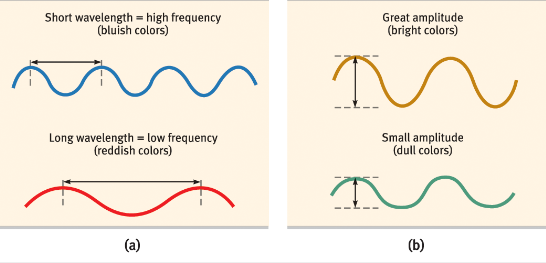
the eye is how we transform physical energy into color, meaning, and depth
the cornea, the eye’s clear protective outer layer covering the pupil and iris, lets in light to bend it into focus
the light then passes into the pupil, the adjustable opening in the center of the eye which allows light through
the pupil opens because of the the ring of muscle tissues that controls the size of the opening, the iris, which also forms eye color
the iris constricts and dilates based on cognitive and emotional states alongside the outside stimuli entering it
after the pupil, light enters the lens or the transparent structure behind the pupil that changes shape to focus images onto the retina
the retina is the light-sensitive back inner surface of the eye which contains receptor rods and cones alongside neurons that process the visual information
the retina undergoes accommodation where the lens of the eye changes shapes to focus images of near or far objects onto it
myopia - nearsightedness can be fixed with contacts
the eye processes the millions of neural energy impulses, which the brain then assembles them into what we perceive
inside of the retina, photoreceptor cells convert light energy into chemical changes to activate the nearby bipolar cells, activating their neighboring ganglion cells, and then forming the optic nerve or the nerve that carries neural impulses to the brain
rods are retinal receptors that detect black, white, and gray that are sensitive to movement allowing us peripheral and twilight vision
rods cluster in the retina’s outer regions, pooling faint energy output to a single bipolar cell to relay to the visual cortex
cones are retinal receptors that are concentrated near the center and function in daylight or lit conditions, giving us detail and color
cones cluster around the fovea or the focal point of the retina, transmitting one message to a single bipolar cell to relay to the visual cortex
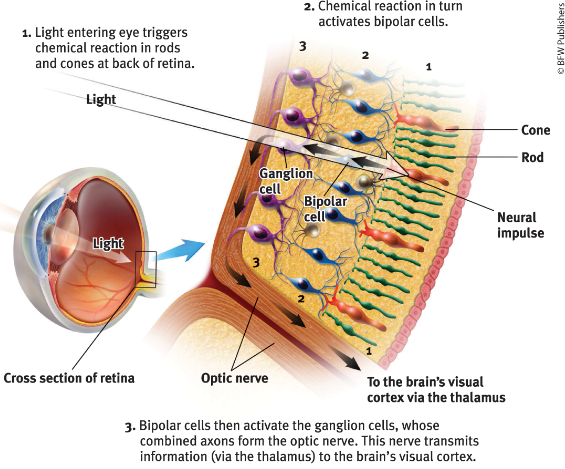
our eye’s blind spot is the point where the optic nerve leaves the eye creating a blind spot since no receptor cells are located there
our retina also analyzes and encodes sensory information to the occipital lobes after crossing the optic chiasm
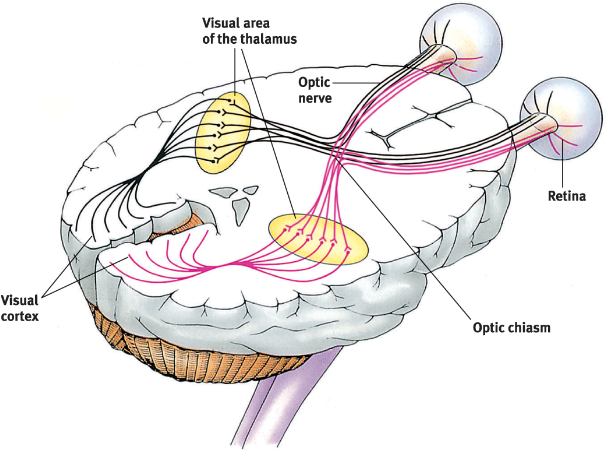
color is perception; light waves have no color but our brain creates the experiences of sight
the Young-Helmholtz trichromatic theory suggests that the retina contains three different types of color receptors, sensitive to either red, green, or blue, which stimuli can produce in combination the perception of any color
color-deficient vision results in a lack of functioning of red or green cones, which prompts the question why individuals can still see yellow and purple
afterimages and opponent colors resulted in the opponent-process theory that suggests that opposing retinal processes (red-green, blue-yellow, white-black) enable our color vision from tiring the other
feature detectors are nerves in the brain’s visual cortex that responses to specific features of stimuli, such as shape, angle, and movement
feature detectors pass the specific information to supercell clusters in the cortical areas
specialized cells in supercell clusters integrate one type of stimulus to fire only when the cues indicate to do so
the fusiform face area of the temporal love helps us recognize faces, and reveals that our perception of other objects occur separately in various regions of the brain
our brains take advantage of parallel processing, or processing multiple aspects of a stimulus or problem simultaneously, to construct the different subdimensions of vision
Module 1.6c Sensation: Hearing
audition is the sense or act of hearing
sound waves very in height, amplitude, depends on the perceived loudness
frequency is the number of complete wavelengths that pass a point in a given time (Hz)
pitch is the tones experienced highness or lowness, depending on frequency
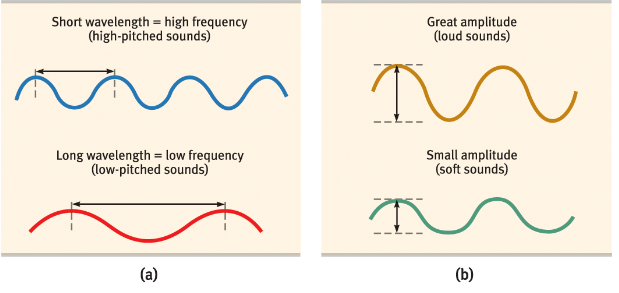
sound intensity is measured in decibels, zero decibels represent the absolute threshold with 60 decibels around the normal conversation
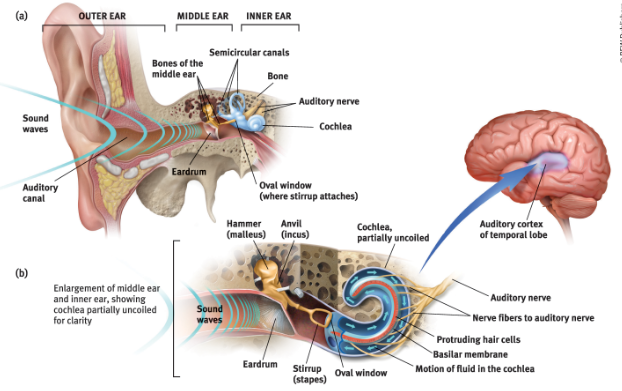
when soundwaves strike your eardrum, the membrane vibrates and triggers nerve impulses to decode as sounds
the middle ear is the chamber between the eardrum and the cochlea containing three tiny bones that concentrate the vibrations of the eardrum on the cochlea’s oval window
the piston is composed of the hammer, anvil, and stirrup
the piston picks up vibrations and transmits them to the cochlea, the coiled bony fluid-filled tube in the inner ear where sound waves travel through cochlear fluid to trigger nerve impulses
the inner ear is the innermost part of the ear containing the cochlea, semicircular canals, and vestibular sacs
the basilar membrane ripples and bends the hair cells with cilia, triggering impulses to the auditory nerve to be carried to the thalamus and auditory cortex
sensorineural hearing loss is damage to the cochlea’s receptor cells or the auditory nerve, the most common and known as nerve deafness
conduction hearing loss is damage to the eardrum and bones that conduct sound waves to the cochlea
a cochlear implant is a device that converts sounds into electrical signals and stimulates the auditory nerve through electrodes threaded into the cochlea
hearing has a critical period which allow proficient learning and restoration, leading to less social isolation and depression
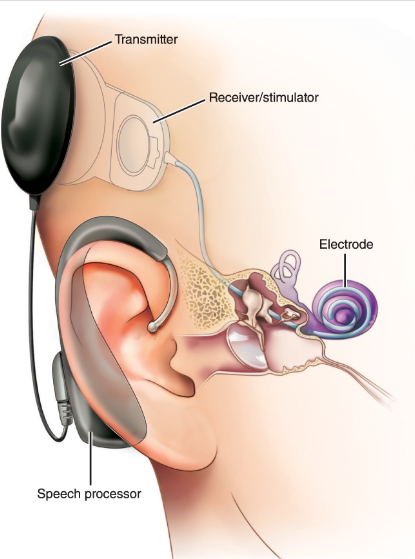
loudness is interpreted from the number of activated hair cells, and the loss of sensitivity to soft sounds is the only difference in terms of loudness
place theory (place coding) assumes that the pitch we hear is a result of sound waves triggering different areas of the cochlea’s membrane (high frequencies produce large vibrations near the base of the cochlea’s membrane)
frequency theory (temporal coding) suggests the rate that nerve impulses travel up the auditory nerve matches the frequency of the tone
the two theories create the volley theory, where the two theories work together to create a combined frequency
our ears allow us to have stereophonic, or 3D hearing based on how fast sound travels into our ears
the supersensitive auditory system detects a noticeable difference in the direction of two sound sources based on how intense a sound arrives into your ear (time)

Module 1.6d Sensation: Skin, Chemical, and Body Senses and Sensory Interaction
touch, our tactile sense, is vital in aiding our development and well-being
our “sense of touch” is a mixture of sensitivity to pressure, warmth, cold, and pain - all other sensations being variations on our skin activating various receptors and pain spots
touch sensation also involves cognition in our brain’s influence of the sensory response, such as a a straight man being caressed by a woman versus a guy
pain is our body’s way of telling us something is wrong, enhancing our self-awareness and arousing and promoting empathetic social connections
pain is an approach from bottom-up sensations and top-down cognition, in a biopsychosocial approach
nociceptors in the skin, muscles, and organs detect harmful temperatures, pressure, or chemicals

pain depends partly on genes you inherit and your physical characteristics like gender, the gate-control theory suggesting that the spinal cord contrails a neurological “gate” that blocks pain signals or allows them to pass to the brain, opened by the activity of signals in small nerve fibers and closed by larger fibers or information from the brain
chronic pain can therefore be treated with gate-closing stimulation like massage and acupuncture
endorphins respond to pain and can either boost the response to pain or disrupt the circuit not bringing pain
the brain can create pain, such as phantom limb sensations, when it lacks normal sensory input and interprets CNS activity
hearing loss similarly creates tinnitus, the phantom ringing in the ears not produced by the vibrating air molecules - vision loss creating phantom sights - taste damage creating phantom tastes and smalls
the perception of pain depends on the attention we focus on it, and can be altered by the memories of pain based on the pain’s peak moment and amount of pain in the end
our expectations and culture varies our perception of pain, tending to perceive more pain when others also experience similar pain
pain control therapies can treat the psychological phenomenon, such as placebos that dampen the CNS’s attention and responses to experiences mimicking painkillers
drawing attention away from pain activates brain pathways that inhibit pain and increase tolerance - immersing oneself is an effective distraction
gustation, our sense of taste, involves sensations of sweet, sour, salty, and bitter - later identifying savory umami, and oleogustus or the taste of fat
taste-exposure allows us to develop preference after extensive exposure, since our biology has us programmed to avoid bitter foods
sweet detects energy, salty detects sodium, sour detects acid, bitter detects poison, umami detects proteins, and oleogustus detects fats for energy and cell growth
the thousands of bumps contain pores that bind to food chemicals and release neurotransmitters to matching cells in our temporal lobes
expectations also influence taste of various items
olfaction is our sense of smell, and is also a chemical sense in the sense molecules of a substance reach receptor cells in the nasal cavity
olfactory neurons bypass the thalamus because of biological developments to smell food, and the pheromones (olfactory chemical messages) secreted as sexual attractants
odor molecules use different receptors to detect them, slipping into receptors that trigger combinations for the olfactory cortex to process into odors
people in relationships learn to recognize their scents and drop stress levels as a result of our learned associations
the appeal depends on learned associations, however often times it is harder to describe and recall smells
our brain is able to recognize odors and associate memories to them, bringing trauma and nostalgia to the limbic and nose areas
position and motion sensors in muscles tendons, and joins known as proprioceptors provide feedback and enable our sense of kinesthesis, or our movement sense responsible for sensing position and movement of individual body parts
our vestibular sense (our balance sense) monitors the head and body’s position and movement, coming from two structures in the inner ear - faster than all other senses
semicircular canals filled with fluid and calcium crystal filled vestibular sacs stimulate hair-like receptors that send signals to the cerebellum
Sensory System | Source | Receptors | Key Brain Areas |
Vision | Light waves striking the eye | Rods and cones in the retina | Occipital lobes |
Hearing | Sound waves striking the outer ear | Cochlear hair cells (cilia) in the inner ear | Temporal lobes |
Touch | Pressure, warmth, cold, harmful chemicals | Receptors (including nociceptors) in the skin, which detect pressure, warmth, cold, and pain | Somatosensory cortex |
Taste | Chemical molecules in the mouth | Basic taste receptors for sweet, sour, salty, bitter, umami, and oleogustus | Frontal/temporal lobe border |
Smell | Chemical molecules breathed in through the nose | Millions of receptors at the top of the nasal cavities | Olfactory bulb |
Kinesthesis | Any change in position of a body part interacting with vision | Kinesthetic sensors in joints, tendons, and muscles (proprioceptors) | Cerebellum |
Vestibular | Movement of fluids in the inner ear caused by head/body movement | Hair-like receptors (cilia) in the ears’ semicircular canals and vestibular sacs | Cerebellum |
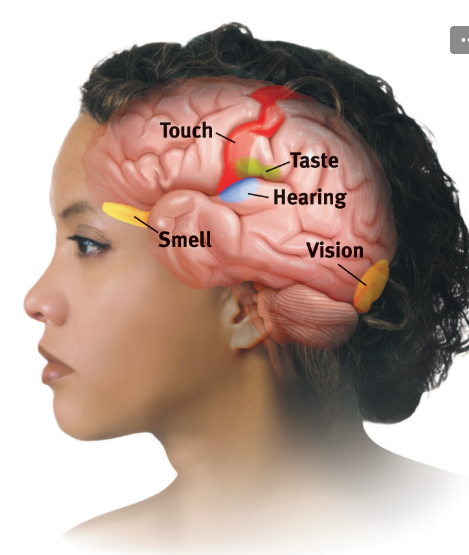
sensory interaction is the principle that one sense can influence another, such as when smell of food influences taste
food molecules released by chewing rise into your nasal cavity for example, and influences the smell receptors to perceive our taste of the food
vision and hearing interact when light becomes more visible accompanied by a short bust of sound and vice versa - such as closed captions
the McGurk effect is the phenomenon where we perceive and blend the stimulus we hear and see when talking with people
the bottom-up sensations and top-down cognitions form our embodied cognition, or the influence of bodily sensations, gestures, and states on our cognitive preferences and judgments
sometimes the brain circuits become joined in synesthesia, which stimulates one of the senses triggered by experiencing another (hearing activates color, color activates tastes)